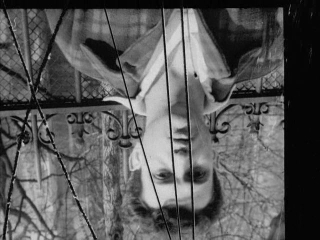Date: 19 October 2012 | Season: London Film Festival 2012 | Tags: London Film Festival
ON VENOM AND ETERNITY
Friday 19 October 2012, at 6:30pm
London BFI Southbank NFT 3
Isidore Isou, Traité de bave et d’éternité, France, 1951, 120 min (new print)
The first and only film by the founder of the French Lettrist movement begins with a warning: ‘Dear spectators, you are about to see a discrepant film. No refunds will be given.’ Advocating for the rupture of language and photography, Isou expects the spectator to ‘leave the cinema blind, his ears crushed, both torn asunder by the disjunction of word and image’. At the 1951 Cannes Festival, where Traité received its first pubic screening, it won the admiration of Guy Debord and Jean Cocteau, who wondered if it would take 50 years before its radical aesthetics could be understood. The Lettrists believed the development of cinema had been stalled by the domination of the studio system. In order for a new cinema to emerge, it had first to be destroyed – symbolically and physically – by bleaching and scratching the images, and by replacing soundtracks with abrasive concrete poetry and enraged tirades.
PROGRAMME NOTES
ON VENOM AND ETERNITY
Friday 19 October 2012, at 6:30pm
London BFI Southbank NFT 3
TRAITÉ DE BAVE ET D’ÉTERNITÉ (ON VENOM AND ETERNITY)
Isidore Isou, France, 1951, 35mm, b/w, sound, 120 min
Isidore Isou arrived in Paris from Romania in 1945 where he founded the Letterist movement, an art and literary movement that owed inspiration to Dada and Surrealism. Letterism attempted to break down poetry into letters and syllables, and then all arts into their constituent parts, to build up new languages for each art form. Isou wrote, directed, photographed, composed the music for, and acted in Traité de bave et d’éternité (Treaty On Venom And Eternity), the first Letterist film manifesto. Isou proceeds to discuss what is wrong with the cinema and then counter it with what he thinks the cinema should consist of through ‘Discrepant Cinema’ in which the sound and the picture are purposefully unrelated and the images are manipulated or destroyed through bleaching and scratching.
Isou brought Traité de bave et d’éternité uninvited to the Cannes Film Festival (1951) where it both caused a riot and won the audience prize for the avant-garde. Isou’s ‘revolt against cinema’ is a landmark work that prefigured the Letterist and Situationist cinema to come and influenced many experimental filmmakers, including Stan Brakhage. The film’s participants include some of the greatest names in 20th Century French arts and letters: Jean-Louis Barrault, Blaise Cendrars, Daniel Gélin, Colette Marchand, André Maurois, and Jean Cocteau (who also designed the poster promoting the 1952 release on the Champs-Elysees). (Re:Voir)
In the above context of The Lumières and Méliès as ‘the 2 wings’ of Film, I take Isou to be the visceral backbone, complete with electrically ‘scratched’ nervous system synopting – all rhythms tending to that consciousness we know as cathexis or investment. His Traité has certainly been prime inspiration for all of my film-making, since I first saw it, and for many of the U.S. independent film-makers … and I do not mean simply for (how did you put it?) the ‘scratch or blinking films’. The verbal rethoric of Traité is at one with the aesthetic of the moving picture imagery and in its subtle weave of be-seemingly dull photography (which effectually obliterates traditional and slavishly composed photography – whether scratched-over, turned upside-down or not). Traité opened each sensibility (that will be open to it) for new feeling about film, thus for the new feelings each might have uniquely rising in each self appropo [sic] that which is intrinsically Film. I know no other works of cinema which, without intruding its own aesthetic, more frees human sensibility to dance, in the mind’s eye, with cinematic possibilities. (Letter from Stan Brakhage to Frédérique Devaux)
Back to top
